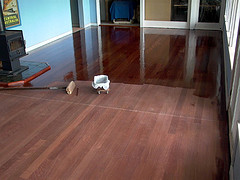Wood Floor Refinishing FAQs
 It's a thrill akin to finding buried treasure -- that moment when you rip up the dusty carpets of your newly purchased home and discover that (bingo!) there are hardwood floors underneath. Wooden floors are one of the most enduringly popular home decor features. And no wonder. Handsome, natural, and durable, they are also relatively easy to restore to their original beauty, even if they've seen their fair share of neglect.
It's a thrill akin to finding buried treasure -- that moment when you rip up the dusty carpets of your newly purchased home and discover that (bingo!) there are hardwood floors underneath. Wooden floors are one of the most enduringly popular home decor features. And no wonder. Handsome, natural, and durable, they are also relatively easy to restore to their original beauty, even if they've seen their fair share of neglect.
Find out the answers to frequently asked questions about the refinishing process below.
Q. How much does wood floor refinishing cost?
A. Expenses of DIY refinishing include rental of a buffer or sander, sandpaper, and possibly chemical stripper, plus your finishing agent and sealant. The cost to hire a professional for wood floor refinishing is usually calculated by the square foot.
Q. Does preparing a hardwood floor for refinishing mean stripping it down to the bare wood?
A. Assess the floor's condition. Are the scratches or nicks you see just surface flaws? If so, scuff-sanding with a buffer may be all that is needed to remove superficial signs of wear and prepare the floor for application of a polyurethane finish.
Q. What are the advantages of scuff-sanding?
A. Scuff-sanding is quick, easy, and inexpensive, compared to sanding down to the wood itself.
Q. What equipment is needed for standard sanding?
A. Renting a random orbital sander is best if you’re planning to refinish wood floors yourself. It will take more time than a drum sander, but you'll have greater control and minimize the possibility of marking up your flooring.
Q. Do nails in the wood need to be removed before refinishing?
A. No. Hammer them down approximately one-quarter inch below the surface of the hardwood flooring before sanding. Use wood filler to cover nails prior to finishing the whole floor.
Q. What type of sandpaper should be used?
A. Go over the floor with coarse-grit, changing your sanding disk once or twice as required. Then repeat the process with medium-grit sandpaper. You may wish to do a third sanding with a finer grit.
Q. When is chemical stripping preferable to sanding?
A. Chemical stripping is a practical choice when the floor wood to be refinished is in good shape. It will quickly remove the old finish, but won’t improve any imperfections in the wood itself.
Q. What equipment is needed for chemical stripping?
A. In addition to the stripper, you’ll need a putty knife, denatured alcohol, steel wool, sandpaper and possibly turpentine or paint remover. Rubber gloves and goggles to protect your skin and eyes are a must.
Q. Which types of wood floor finish are available?
A. There are 4 main types for residential purposes:
- Surface finishes, such as stains, are durable and low maintenance. However, they do emit an odor after application. Depending on the variety, they take anywhere from 2-8 hours to dry.
- Waxes soak into the wood for a durable protective finish. However, they have a low luster and are vulnerable to water spotting.
- UV cured finishes are super-quick-drying, water based finishes, which are "cured" with ultraviolet light. These are ideal if you'd like to use the floors immediately.
- Finishing oils are mixtures of natural oils (for example, tung) with additional ingredients to facilitate a fast-drying, durable surface.
Q. Is sealing necessary after you've applied the finish to your hardwood floors?
A. It depends on the floor. Usually it is necessary only with floors that absorb stain unevenly.
Q. How long does it take to refinish a wood floor?
A. The time frame varies according to how many rooms you are doing and what type of finish you’re using. A rough estimate is 3-5 days to sand and refinish all the flooring in an average home, applying polyurethane. Refinishing is best done in warm, non-humid weather, to allow adequate ventilation and speed up the drying process.
Laura Firszt writes for networx.com.
Updated October 30, 2018.
Looking for a Pro? Call us (866) 441-6648

Flooring Average Costs
Flooring Contractors Experiences

Glossy New Kitchen Floor Tile … At Last!

New Vinyl And Hardwood Flooring To Replace Water Damaged Floors



